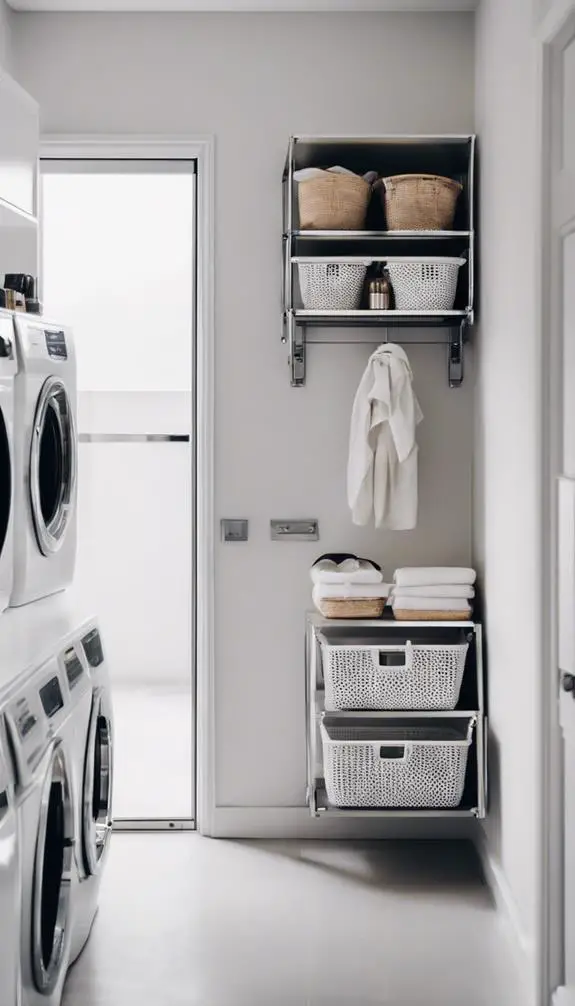As you stand in your laundry room, surrounded by piles of dirty clothes and cluttered shelves, you can't help but think there must be a better way. You're not alone – a disorganized laundry room can be overwhelming and make a necessary chore even more dreaded. But what if you could transform this space into an efficient and stress-free zone? By evaluating your specific needs and implementing clever storage solutions, you can create a room that makes doing laundry a breeze. But where do you start, and what strategies will make the biggest impact?
Summary
- Assess laundry habits and room dimensions to optimize storage, sorting, and folding areas for efficient workflow.
- Install vertical shelves, storage ladders, and wall-mounted storage to maximize space and reduce clutter.
- Designate a folding and ironing station with a sturdy surface, built-in shelves, and a laundry sorter for streamlined tasks.
- Implement a sorting and separation system for delicates, hand wash items, and durable fabrics to prevent damage and extend lifespan.
- Establish daily habits and schedule consistency checks to maintain the organized space and make adjustments as needed.
Assessing Your Laundry Room Needs

As you stand in your laundry room, surrounded by piles of dirty clothes and detergent boxes, take a moment to think about how you really want this space to function.
Consider your laundry habits: how often do you do laundry, and how much space do you need for sorting, folding, and ironing?
Think about the laundry room dimensions: are there any awkward corners or tight spaces that need to be optimized?
Do you have a lot of bulky items like comforters or pillows that require special care?
Maximizing Vertical Storage Space
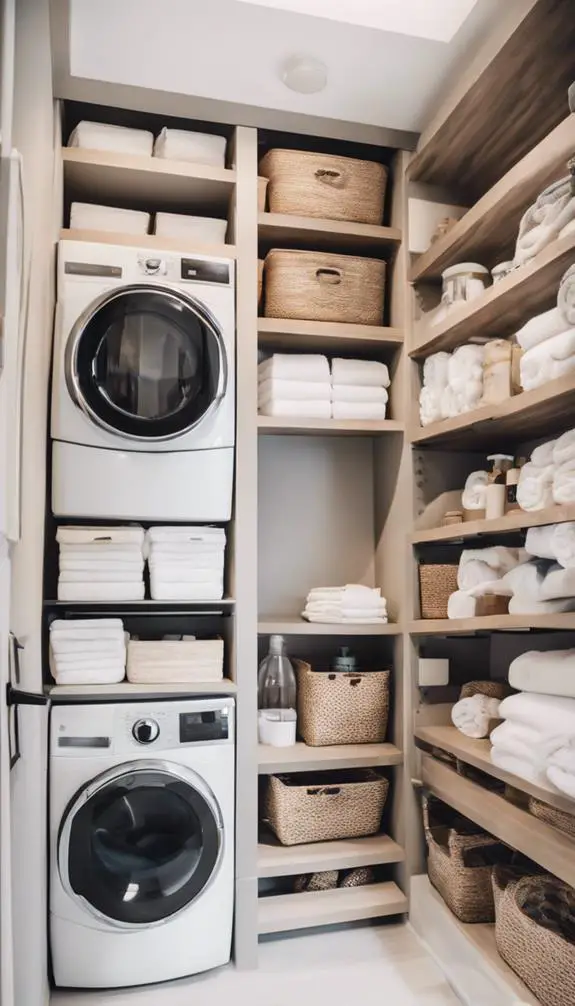
You've got a clear vision of your ideal laundry room, now it's time to make the most of the space you have.
To maximize vertical storage space, install vertical shelves that extend from floor to ceiling. This will provide ample room for storing laundry supplies, linens, and other essentials.
Consider adding storage ladders that can be mounted to the wall, providing easy access to items on higher shelves. By utilizing wall space, you'll free up floor space for larger appliances and create a more efficient workflow.
With clever use of vertical storage, you'll be amazed at how much more functional your laundry room becomes.
Utilizing Hidden Storage Areas
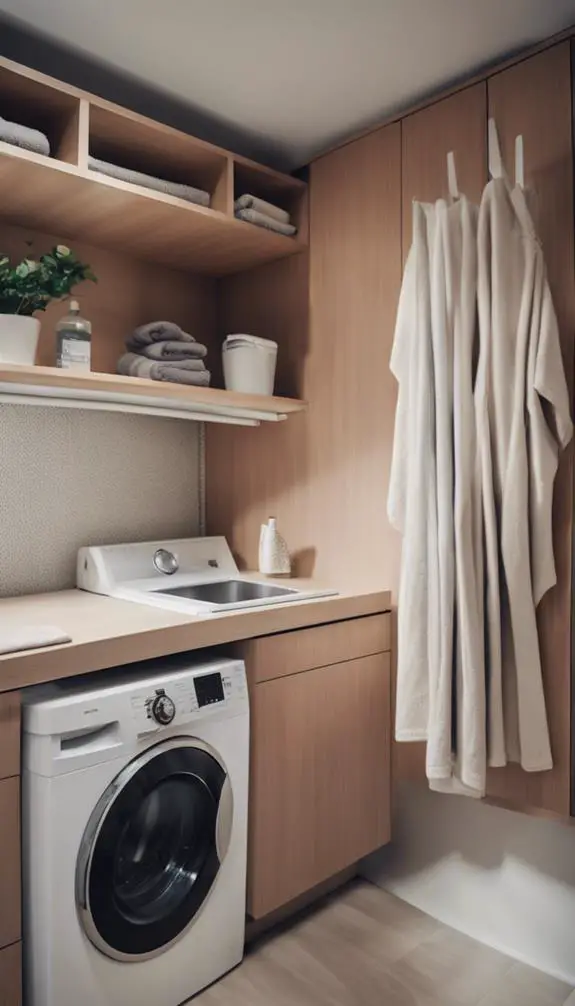
Closets and cabinetry often have hidden pockets of unused space.
You can utilize these areas by installing hidden cabinets or secret shelves specifically designed for laundry room storage. These clever solutions allow you to store items like detergent, fabric softener, or cleaning supplies out of sight.
Consider installing a slide-out drawer or a pull-down shelf to maximize the space above your washer and dryer. You can also use the back of a door or a wall to hang a storage rack or a pegboard.
Creating a Folding Station
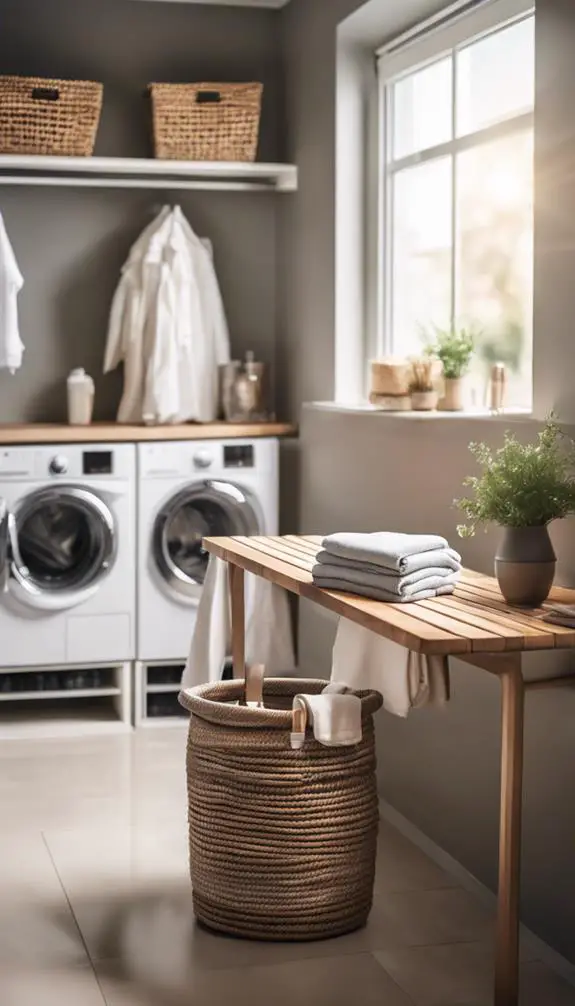
Now that you've optimized your laundry room's hidden storage areas, it's time to focus on creating a functional folding station.
A dedicated space for folding laundry can make a huge difference in your productivity and sanity.
Consider investing in a folding table or a wall-mounted folding board that provides a sturdy surface for folding and stacking clothes.
This will help you stay organized and avoid clutter.
You can also add some built-in shelves or baskets to store folding supplies, like laundry detergent and fabric softener.
With a well-designed folding station, you'll be able to tackle laundry day with ease and efficiency.
Designing a Functional Layout
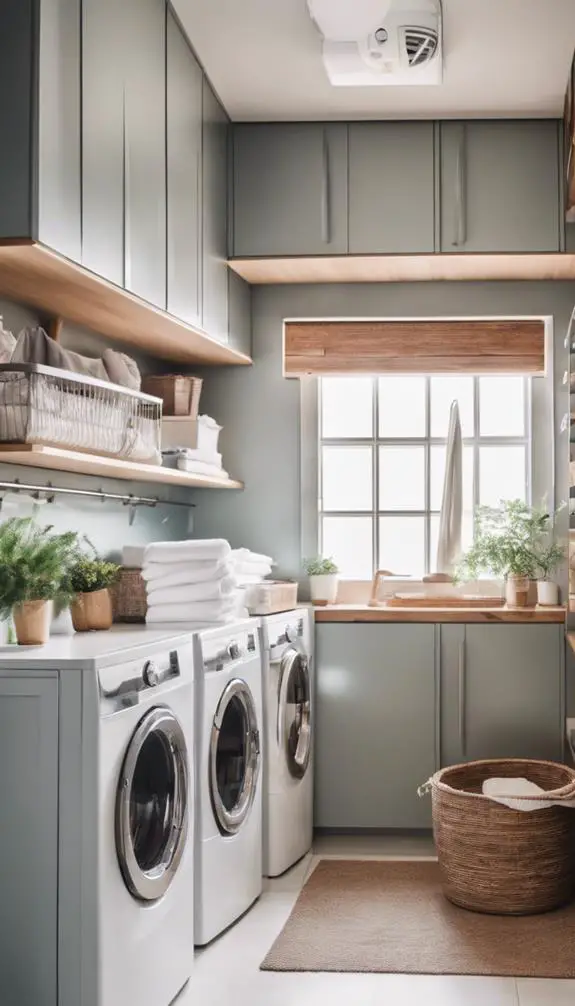
When designing a functional layout for your laundry room, you'll want to allocate work zones to streamline your tasks,
position shelves ideally to store supplies within easy reach, and maximize counter space for folding and ironing.
By doing so, you'll create a workflow that's efficient and hassle-free.
Work Zones Allocation
By allocating specific work zones in your laundry room, you'll be able to tackle tasks more efficiently and effectively.
A well-planned work zone layout allows you to dedicate areas for specific tasks, such as sorting, washing, drying, and folding.
Implement a zone division strategy by assigning a distinct area for each task. This segregation enables you to focus on one task at a time, reducing clutter and increasing productivity.
For instance, designate a section for folding and ironing, and another for sorting and washing. By doing so, you'll create a functional and organized laundry room that streamlines your workflow, saving you time and energy.
Optimal Shelf Placement
You've allocated your laundry room into efficient work zones, and now it's time to focus on designing a functional layout that supports your workflow.
When it comes to ideal shelf placement, consider the height and depth of your shelves. Install shelves at a comfortable height, allowing you to easily access frequently used items without straining.
Verify shelf depth is adequate to hold baskets or bins, keeping items organized and out of sight. Typically, shelves between 12-18 inches deep are ideal for laundry rooms.
Efficient Counter Space
Amidst the hustle and bustle of the laundry room, efficient counter space is essential for a seamless workflow.
You need a surface that's free from clutter, allowing you to fold, sort, and iron with ease. To achieve this, consider a countertop with built-in storage, such as cabinets or drawers, to keep essentials within reach.
Install a countertop organizer or a tray to corral small items, preventing counter clutter. Make the most of your surface space by placing frequently used items, like detergent and fabric softener, near the front of the counter.
Laundry Supply Storage Solutions
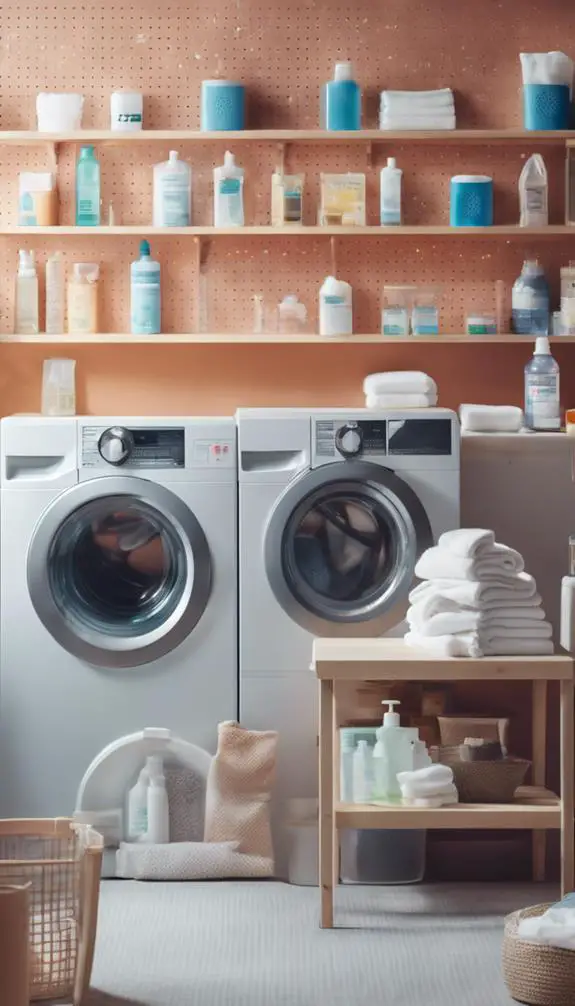
Keeping your laundry supplies within easy reach can save you time and frustration when doing laundry.
You can achieve this by using supply bins with labels, making it easy to identify what's inside. Label makers come in handy for this task, allowing you to create clear and concise labels.
You can place these bins on shelves, in cabinets, or even on the floor, depending on the available space in your laundry room.
This organized system guarantees that you can quickly grab what you need, reducing the time spent searching for misplaced supplies.
With your supplies neatly stored, you'll be able to focus on getting your laundry done efficiently.
Installing a Utility Sink
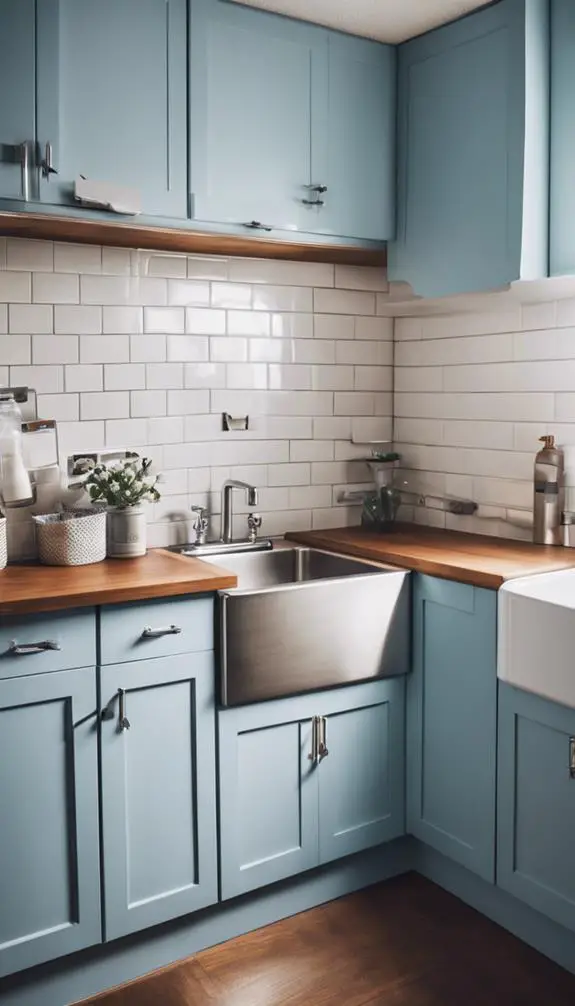
How much easier would laundry day be if you'd a dedicated space to soak, scrub, and rinse bulky or heavily soiled items?
Installing a utility sink in your laundry room can be a game-changer. When considering sink placement, think about the workflow in your laundry room.
Place the sink near the washing machine to create a convenient cleaning station. Choose a faucet that's durable and easy to clean, with a high-arc spout to provide ample clearance for large items.
You'll appreciate the extra space to tackle tough stains and messes. Plus, a utility sink can also serve as a convenient spot to wash delicate items or prep items for ironing.
Hanging Organization Systems
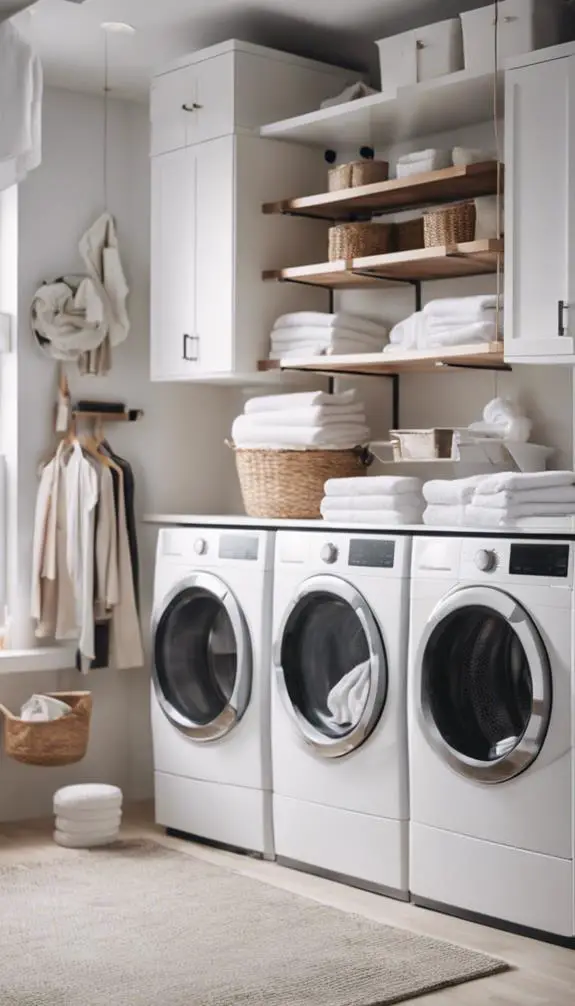
With a utility sink in place, you can now focus on maximizing your laundry room's vertical space.
This is where hanging organization systems come in. Installing hanging rods at different heights will allow you to utilize every inch of your walls.
You can hang items like ironing boards, laundry bags, and even cleaning supplies. Additionally, consider adding laundry hooks for hanging items like delicates or clothes that require air drying.
These hooks can also be used to store items like lint rollers and laundry detergent. By incorporating these hanging organization systems, you'll be able to keep your laundry room clutter-free and make the most of your available space.
Sorting and Separating Laundry

You're probably aware that sorting and separating laundry is a vital step in the cleaning process, but it can be overwhelming if you don't have a system in place.
To make the most of your laundry room organization, you'll want to separate whites from colors to prevent dye bleeds, delicates from durable items to prevent damage, and hand wash items from machine washable ones to guarantee gentle care.
Whites From Colors
Orderliness is the foundation of an efficient laundry room, and it all begins with a crucial step: separating whites from colors.
You'd be surprised how many laundry mistakes you can avoid by developing good sorting habits. Failing to separate whites from colors can lead to dingy whites, ruined clothes, and even damaged fabric.
To avoid these mishaps, designate a specific area in your laundry room for sorting. Use separate hampers or bins labeled "whites" and "colors" to encourage discipline.
Make it a habit to sort clothes as soon as they're dirty to prevent mixing. By implementing this simple step, you'll save time and energy in the long run and guarantee your clothes look their best.
Delicates From Durable
After separating whites from colors, this is vital to further categorize your laundry into delicates and durable items.
Delicate fabrics, like lingerie, silk, or wool, require special care to prevent damage. Fabric segregation is key to ensuring these items don't get ruined. Set aside a separate bin or hamper for delicates, and consider using a mesh laundry bag to protect them during washing.
On the other hand, durable items like towels, jeans, and t-shirts can withstand regular washing cycles. By separating delicates from durable items, you'll prevent damage, reduce wear and tear, and extend the lifespan of your clothes. This simple step will make a big difference in your laundry routine.
Hand Wash Items
Sorting hand wash items is an essential step in your laundry routine, as it certifies these delicate pieces receive the gentle care they require.
You'll want to separate them from machine-washable items to prevent damage or snagging. Designate a specific area for hand wash items, such as a laundry sorter or a designated shelf.
Store hand soap nearby, ideally in a compact dispenser or a decorative soap dish, keeping it easily accessible.
When washing, follow delicate care tips like using lukewarm water, gentle hand soap, and avoiding wringing or twisting. This attention to detail certifies your hand wash items look their best and prolongs their lifespan.
Incorporating a Ironing Station
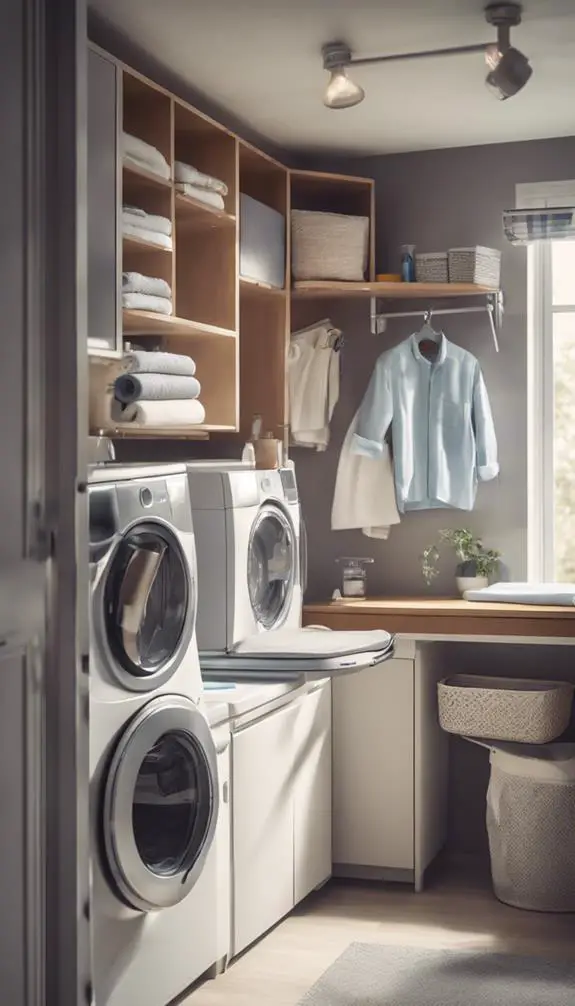
While tackling your laundry room organization project, don't overlook the importance of incorporating a dedicated ironing station.
This station should include ironing essentials like a reliable iron, ironing board, and a heat-resistant ironing board cover.
Consider investing in ironing accessories such as a steam iron, ironing board pad, and a travel iron for added convenience.
By designating a specific area for ironing, you'll be able to quickly and efficiently iron your clothes, saving you time and energy in the long run.
A well-organized ironing station will also help keep your laundry room clutter-free and make the ironing process more enjoyable.
Implementing a Lost Sock System

You're about to tackle one of the most frustrating aspects of laundry day: the lost sock epidemic.
To take control of this chaos, you'll need a system that includes a sock collection station where singles can be deposited, a sock matching process to reunite pairs, and a sock storage solution to keep everything tidy.
Sock Collection Station
By the time you've finished folding the last load of laundry, a single sock has vanished, leaving its mate to languish in the dark recesses of your drawer.
This frustrating phenomenon is a common occurrence in many households.
To combat it, create a sock collection station near your washing machine. Designate a specific spot, like a small bin or basket, where you'll place all single socks.
This way, you'll develop a habit of checking the station before putting away clean laundry, increasing the chances of reuniting mismatched socks.
Implementing this system will help you break the cycle of sock disappearance and maintain a more organized sock drawer.
Sock Matching Process
Your sock collection station is now in place, and it's time to implement a process to match those singles.
You'll need a system to manage the influx of solo socks. Enter the sock sorter, a tool that helps categorize socks by type, color, and size.
As the sock curator, you'll oversee the process, ensuring each sock finds its perfect match. Start by sorting socks into piles based on these criteria.
Then, pair them up, and hang them on a designated sock organizer or store them in a designated bin.
This system will help reduce the number of lost socks and make laundry day more efficient.
Sock Storage Solution
Now that your sock matching process is in place, it's time to think about what to do with those lone socks that still don't have a match.
Implementing a lost sock system will help keep them organized and prevent clutter. Designate a specific area, like a sock cubby or sock drawer, to store these singles.
This way, you can easily find a match when its partner finally turns up. You can also use dividers or small compartments within the cubby or drawer to separate the socks by type or color.
This system will keep your laundry room organized and make it easier to find a match when you need it. By implementing this solution, you'll reduce clutter and make the most of your laundry space.
Adding Decorative Elements
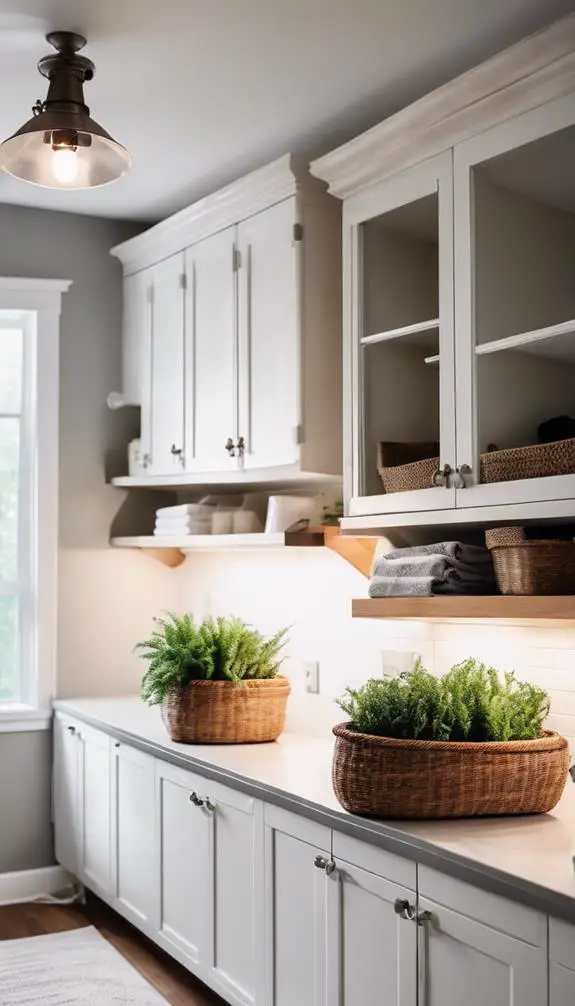
As you step into your newly organized laundry room, you're likely enthusiastic to add some decorative elements that reflect your personal style and make the space feel more inviting.
You can start by hanging Laundry Room Art that complements the room's color scheme and adds a touch of personality. Consider framed prints or canvas pieces that feature fun quotes, laundry-themed illustrations, or abstract designs.
Add Decorative Accents like woven baskets, decorative jars, or a vase with fresh flowers to bring in a pop of color and texture. These elements won't only elevate the space's aesthetic but also create a cozy atmosphere that makes doing laundry a more enjoyable task.
Maintaining Your Organized Space

With your laundry room looking more inviting than ever, it's time to focus on the next step: keeping it that way.
Developing daily habits is key to maintaining your organized space. Set aside a few minutes each day to put away clean laundry, wipe down surfaces, and confirm everything is in its designated spot.
Schedule consistency checks into your weekly routine to assess your space and make adjustments as needed. This could be as simple as dedicating 10 minutes on Sundays to tidying up and restocking supplies.
FAQs
Can I Use a Laundry Room for Other Household Tasks Like Wrapping Gifts?
You can definitely repurpose a laundry room for other tasks, like gift wrapping! Consider converting a section into a craft station, where you can store supplies and wrap presents, freeing up space in your main living areas.
How Do I Keep My Laundry Room Smelling Fresh and Clean All the Time?
You keep your laundry room smelling fresh and clean by using laundry deodorizers, like baking soda or essential oils, and incorporating fresh scents through open windows, air purifiers, or scented candles, ensuring a pleasant atmosphere while you tackle household chores.
Are There Any Laundry Room Organization Ideas for Small or Narrow Spaces?
You'll love these compact solutions for small spaces! Opt for wall-mounted shelves, foldable drying racks, and space savers like over-the-washer storage units to maximize your laundry room's potential without sacrificing functionality.
Can I Install Shelves and Cabinets Myself or Do I Need a Professional?
You can definitely tackle installing shelves and cabinets yourself, but be prepared to face DIY challenges, like measuring accurately and configuring shelf layouts that fit your space; research and planning will help you overcome these hurdles.
How Often Should I Clean and Maintain My Laundry Room Organization System?
You should tidy up your space daily, putting away items after use, and schedule seasonal deep cleans to maintain your system's efficiency, ensuring it continues to serve you well and stays clutter-free.
Conclusion
You've transformed your laundry room into a haven of efficiency! Now, commit to maintaining this space by setting aside time each week to tidy up and guarantee everything stays in its assigned spot. Remember, a well-organized laundry room is not a one-time achievement, but a continuous process. By sticking to your new system, you'll enjoy a stress-free laundry experience and a sense of accomplishment every time you step into this newly optimized space.



